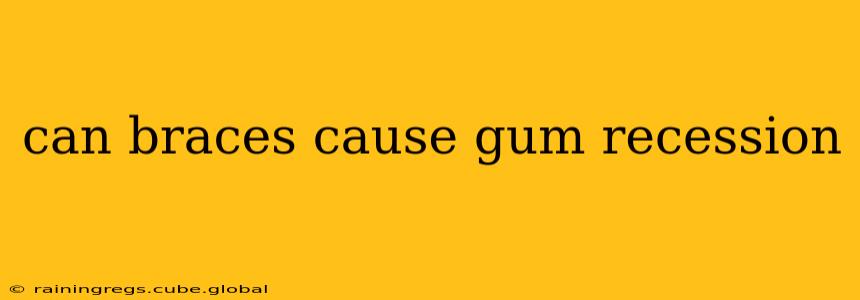Orthodontic treatment with braces is a common procedure to straighten teeth and improve overall oral health. However, a concern that often arises is whether braces can contribute to gum recession. While not a guaranteed outcome, several factors related to braces can potentially lead to gum recession. This article delves into the connection between braces and gum recession, exploring the causes, prevention, and treatment options.
What is Gum Recession?
Gum recession refers to the gradual wearing away of gum tissue, exposing more of the tooth's root. This can lead to several problems, including increased tooth sensitivity, potential root decay, and aesthetic concerns. The exposed root is more vulnerable to temperature changes, acidic foods, and bacteria. Severe gum recession can even lead to tooth loss.
Can Braces Directly Cause Gum Recession?
Braces themselves don't directly cause gum recession. The metal brackets and wires don't actively erode gum tissue. However, certain factors associated with orthodontic treatment can increase the risk:
1. Poor Oral Hygiene:
This is perhaps the most significant factor. Braces create more nooks and crannies where food particles and plaque can easily accumulate. If not meticulously cleaned, this buildup can lead to gingivitis (gum inflammation) and periodontitis (gum disease), both of which are major contributors to gum recession.
2. Excessive Pressure from Braces:
While braces apply gentle pressure to move teeth, excessive or uneven pressure can irritate the gums and contribute to recession. This is more likely to occur if the braces are not properly adjusted or if there are issues with the appliance itself.
3. Aggressive Toothbrushing:
People often try to be extra diligent with brushing when wearing braces, leading to aggressive brushing techniques that can damage gum tissue. Using a hard-bristled toothbrush or brushing too vigorously can abrade the gums and exacerbate recession.
4. Existing Gum Disease:
Individuals already suffering from gum disease (periodontitis) are at a higher risk of experiencing gum recession during orthodontic treatment. The process of moving teeth can potentially worsen pre-existing gum issues.
How Can I Prevent Gum Recession While Wearing Braces?
Preventing gum recession while undergoing orthodontic treatment is crucial. Here's how:
1. Meticulous Oral Hygiene:
Maintain impeccable oral hygiene by brushing thoroughly at least twice a day, using a soft-bristled toothbrush and fluoride toothpaste. Use interdental brushes or floss threaders to clean between the brackets and wires. Regular flossing is essential.
2. Regular Dental Checkups and Cleanings:
Schedule regular professional cleanings and checkups with your orthodontist and dentist throughout the treatment. Professional cleanings remove plaque and tartar that you can't reach with at-home cleaning, preventing gum inflammation and disease.
3. Proper Braces Adjustment:
Ensure your orthodontist adjusts your braces regularly and addresses any discomfort or irritation promptly. Regular adjustments prevent excessive pressure on your gums.
4. Gentle Brushing Technique:
Adopt a gentle, circular brushing motion. Avoid aggressive scrubbing that can damage your gums.
What are the Signs of Gum Recession?
Recognizing the signs of gum recession is important for early intervention. Look for:
- Gums appearing shorter or pulled back from the teeth.
- Exposed tooth roots.
- Increased tooth sensitivity.
- Bleeding gums (gingivitis).
- Loose teeth.
Can Gum Recession Caused by Braces Be Reversed?
In some cases, mild gum recession can be stabilized or improved with diligent oral hygiene and professional treatment. However, severe gum recession may require more advanced procedures such as gum grafting. This surgical procedure involves using tissue from another part of the mouth to cover the exposed root surfaces.
Can Braces Worsen Existing Gum Recession?
Yes, if you already have gum recession before starting braces, the treatment may worsen the existing condition if proper oral hygiene and regular dental checkups aren't strictly followed. Therefore, addressing pre-existing gum disease before beginning orthodontic treatment is vital.
Conclusion:
While braces themselves don't directly cause gum recession, certain associated factors significantly increase the risk. Maintaining excellent oral hygiene, attending regular checkups, and employing a gentle brushing technique are essential to preventing gum recession during and after orthodontic treatment. If you experience any signs of gum recession, consult your dentist or orthodontist promptly. Early detection and treatment are key to preserving your gum health.
